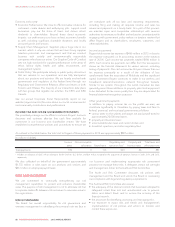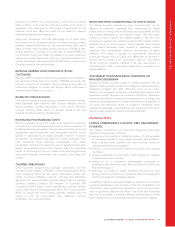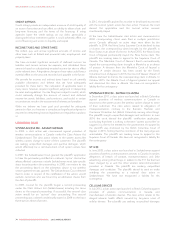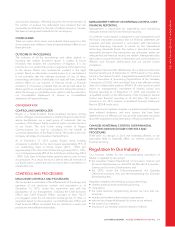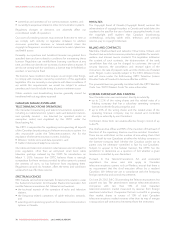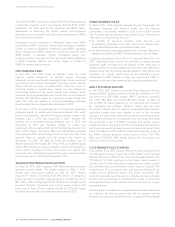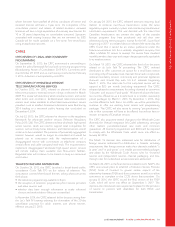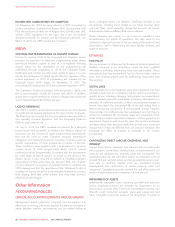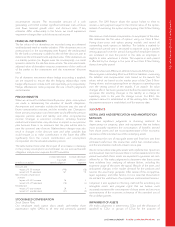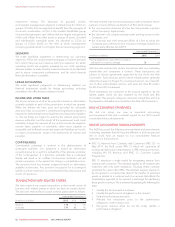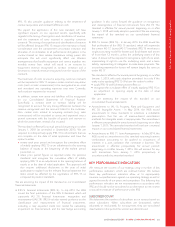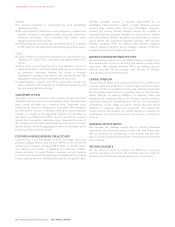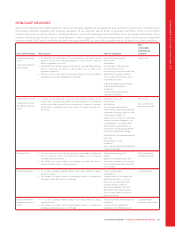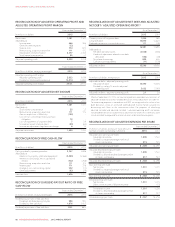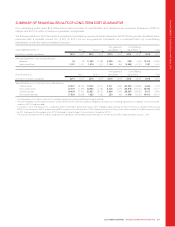Rogers 2015 Annual Report Download - page 80
Download and view the complete annual report
Please find page 80 of the 2015 Rogers annual report below. You can navigate through the pages in the report by either clicking on the pages listed below, or by using the keyword search tool below to find specific information within the annual report.MANAGEMENT’S DISCUSSION AND ANALYSIS
We obtained AWS-1 spectrum licences from Shaw after exercising
a previously acquired option and paying the final $100 million
installment. The total paid for the spectrum was $350 million.
Subsequent to exercising the option, certain non-contiguous
spectrum licences acquired from Shaw were transferred to WIND
for nominal cash proceeds.
Subsequent to the acquisition of Mobilicity, Rogers and WIND
undertook an AWS-1 spectrum licence asset exchange in Southern
Ontario to create an additional 10 MHz of paired AWS-1 spectrum
that is contiguous to AWS-1 spectrum licences we acquired in the
2008 auction. In addition, Rogers transferred certain non-
contiguous AWS-1 spectrum licences previously held by Mobilicity
in British Columbia, Alberta, and various regions in Ontario to
WIND for nominal cash proceeds.
CRTC WIRELESS CODE
In June 2013, the CRTC issued its Wireless Code. The code
imposes several obligations on wireless carriers, including
maximum contract term length, roaming bill caps, device unlocking
requirements, and contract summaries. It also lays out the rules for
device subsidies and early cancellation fees. Under the code, if a
customer cancels a contract early, carriers can only charge the
outstanding balance of the device subsidy they received, which
decreases by an equal amount every month over no more than 24
months. This effectively makes the maximum contract length two
years. The code was applied to contracts (excluding enterprise
plans) entered into or renewed after December 2, 2013.
As of June 3, 2015, the code applied to all contracts (excluding
enterprise plans), no matter when they were entered into, which
means it retroactively captured three-year contracts entered into
between June 3, 2012 and December 2, 2013. Anyone who
entered into a three-year contract between June 3, 2012 and
December 2, 2013 was therefore entitled to cancel their
agreement without paying back the full subsidy they received. On
July 2, 2013, Rogers, Bell, Telus, MTS, and SaskTel filed a Federal
Court appeal of this retroactivity provision of the code. The Court
granted leave to appeal and the appeal was heard on
November 12, 2014. On May 19, 2015, the Federal Court of
Appeal dismissed the Rogers, Bell, Telus, MTS, and SaskTel appeal
of the CRTC decision to apply the Wireless Code to all contracts on
June 3, 2015, regardless of when the contract was signed. This
means the code retroactively captured three-year contracts entered
into between June 3, 2012 and December 2, 2013.
2500 MHZ SPECTRUM LICENCE AUCTION
On April 14, 2015, ISED Canada’s 2500 MHz commercial wireless
spectrum auction began. The auction ended on May 5, 2015.
Results were announced publicly on May 12, 2015. Rogers
acquired 41 licences consisting of 20 MHz blocks of contiguous,
paired spectrum in Canada’s major geographic markets at a cost of
$27 million. After making payment for the licences and passing the
required Canadian Ownership and Control review, Rogers took
possession of these 20-year licences on May 27, 2015 and began
to deploy the spectrum during the second quarter of 2015.
TOWER SHARING POLICY
In March 2013, ISED Canada released Revised Frameworks for
Mandatory Roaming and Antenna Tower and Site Sharing,
concluding a consultation initiated in 2012. It sets out the current
rules for tower and site sharing, among other things. The key terms
of the tower and site sharing rules are:
• all holders of spectrum licences, radio licences, and
broadcasting certificates must share towers and antenna sites,
where technically feasible, at commercial rates; and
• the timeframe for negotiating agreements is 60 days, after which
arbitration according to ISED Canada arbitration rules will begin.
In Telecom Regulatory Policy 2015-177 released May 2015, the
CRTC determined that it would not mandate or require general
wholesale tariffs for tower and site sharing. At the same time, it
determined that its existing powers and processes are sufficient to
address tower and site sharing disputes related to rates, terms, and
conditions. As a result, carriers may use the arbitration process
established by ISED Canada, or they may request the CRTC to
intervene in the event that tower and site sharing negotiations fail.
AWS-3 SPECTRUM AUCTION
In July 2014, ISED Canada announced that Advanced Wireless
Services (AWS-3) wireless spectrum would be auctioned in 2015
and before the 2500 MHz auction. AWS-3 spectrum comprises
the 1755-1780 MHz and 2155-2180 MHz bands. 30 MHz of
the 50 MHz of paired spectrum to be auctioned was reserved
for “operating new entrants”. Wireless carriers with less than
10 percent national and 20 percent provincial/territorial wireless
subscribermarketsharewereeligibletobidontheset-aside
spectrum in licence areas where they were then providing service.
The 20 MHz of spectrum not subject to the new entrant set-aside
was auctioned in two 5+5 MHz sub-blocks. The auction used a
sealed-bid format. The highest bid for a block would win the block
and the winner would then pay the second highest bid price for the
block. On March 6, 2015, ISED Canada announced the results of
the AWS-3 wireless spectrum licence auction of the 1755-1780
MHz and 2155-2180 MHz bands. Rogers did not acquire any
spectrum licences in this auction.
3.5 GHZ BAND POLICY CHANGES
In December 2014, ISED Canada released its policy changes to the
3.5 GHz spectrum band. Rogers has a 50% interest in the Inukshuk
Wireless Partnership (IWP) which holds (on average) between 100-
175 MHz of 3.5 GHz spectrum in most major urban markets in
Canada. The 3.5 GHz band will be reallocated for mobile services
(it is currently only licensed for fixed wireless access in Canada). The
establishment of a new band plan and licensing framework for
mobile services will be the subject of a future consultation. The
band will eventually be relicensed on a flexible-use basis whereby
licensees will be permitted to determine the extent to which they
will implement fixed and/or mobile services in the band in a given
geographic area.
Until the future consultation is completed and the related decisions
are released, all existing licences that will be renewed will be
limited to the provision of fixed services. Licences will be renewed
78 ROGERS COMMUNICATIONS INC. 2015 ANNUAL REPORT


